Responses of Total Biomass, Shoot Dry Weight, Yield and Yield Components of Jerusalem Artichoke (Helianthus tuberosus L.) Varieties under Different Terminal Drought Duration
Abstract
1. Introduction
2. Materials and Methods
2.1. Experimental Design
2.2. Crop Management
2.3. Water Management
2.4. Data Collection
2.4.1. Determination of Soil Properties and Weather Conditions
2.4.2. Determination of Soil Moisture Content and Relative Water Content
2.4.3. Determination of Total Biomass, Shoot Dry Weight, Tuber Yield, Harvest Index, and Yield Components
2.5. Statistical Analysis
3. Results
3.1. Soil Moisture Contents and Plant Water Status
3.2. Combined Analysis of Variance for Growth, Yield, and Yield Components
3.3. Performance of Jerusalem Artichoke Genotype under Different Terminal Drought Durations
4. Discussion
5. Conclusions
Author Contributions
Funding
Acknowledgments
Conflicts of Interest
References
- Saengthongpinit, W.; Sajjaanantakul, T. Influence of harvest time and forage temperature on characteristics of inulin from Jerusalem artichoke (Helianthus tuberosus L.) tubers. Postharvest Biol. Technol. 2005, 37, 93–100. [Google Scholar] [CrossRef]
- Schittenhelm, S. Agronomic performance of root chicory, Jerusalem artichoke, and sugarbeet in stress and non-stress environments. Crop. Sci. 1999, 39, 1815–1823. [Google Scholar] [CrossRef]
- Seiler, G.J.; Campbell, L.G. Genetic variability for mineral element concentrations of wild Jerusalem artichoke forage. Crop. Sci. 2004, 44, 289–292. [Google Scholar] [CrossRef]
- Sritiawthai, E.; Kaewtapee, C.; Bunchasak, C.; Poeikhampha, T. Effect of Jerusalem artichoke (Helianthus tuberosus L.) supplementation on production performances, egg quality characteristics and intestinal microflora of laying hens. J. Appl. Sci. 2013, 13, 183–187. [Google Scholar] [CrossRef][Green Version]
- Rodrigues, M.A.; Sousa, L.; Cabanas, J.E.; Arrobas, M. Tuber yield and leaf mineral composition of Jerusalem artichoke (Helianthus tuberosus L.) grown under different cropping practices. Span. J. Agric. Res. 2007, 5, 545–553. [Google Scholar] [CrossRef][Green Version]
- Barclay, T.; Ginic-Markovic, M.; Coope, P.; Petrovsky, N. Inulin-a versatile polysaccharide with multiple pharmaceutical and food chemical uses. J. Excip. Food Chem. 2010, 1, 27–50. [Google Scholar]
- Puttha, R.; Jogloy, S.; Wangsomnuk, P.P.; Srijaranai, S.; Kesmala, T.; Patanothai, A. Genotypic variability and genotype by environment interactions for inulin content of Jerusalem artichoke germplasm. Euphytica 2012, 183, 119–131. [Google Scholar] [CrossRef]
- Sennoi, R.; Jogloy, S.; Saksirirat, W.; Patanothai, A. Pathogenicity test of Sclerotium rolfsii, a causal agent of Jerusalem artichoke (Helianthus tuberosus L.) stem rot. Asian J. Plant Sci. 2010, 9, 281–284. [Google Scholar] [CrossRef]
- Puangbut, D.; Jogloy, S.; Vorasoot, N.; Patanothai, A. Responses of growth, physiological traits and tuber yield in Helianthus tuberosus to seasonal variations under tropical area. Sci. Hortic. 2015, 195, 108–115. [Google Scholar] [CrossRef]
- Ruttanaprasert, R.; Jogloy, S.; Vorasoot, N.; Kesmala, T.; Kanwar, R.S.; Holbrook, C.C.; Patanothai, A. Photoperiod and growing degree days’ effect on dry matter partitioning in Jerusalem artichoke. Int. J. Plant Prod. 2013, 7, 393–416. [Google Scholar]
- Puangbut, D.; Jogloy, S.; Vorasoot, N.; Patanothai, A. Growth and phenology of Jerusalem artichoke (Helianthus tuberosus L.). Pak. J. Bot. 2015, 47, 2207–2214. [Google Scholar]
- Puangbut, D.; Jogloy, S.; Vorasoot, N. Association of photosynthetic traits with water use efficiency and SPAD chlorophyll meter reading of Jerusalem artichoke under drought conditions. Agric. Water. Manag. 2017, 188, 29–35. [Google Scholar] [CrossRef]
- Ruttanaprasert, R.; Jogloy, S.; Vorasoot, N.; Kesmala, T.; Kanwar, R.S.; Holbrook, C.C.; Patanothai, A. Effect of water stress on total biomass, tuber yield, harvest index and water use efficiency in Jerusalem artichoke. Agric. Water Manag. 2016, 166, 130–138. [Google Scholar] [CrossRef]
- Ruttanaprasert, R.; Banterng, P.; Jogloy, S.; Vorasoot, N.; Kesmala, T.; Kanwar, R.S.; Holbrook, C.C.; Patanothai, A. Genotypic variability for tuber yield, biomass and drought tolerance in Jerusalem artichoke germplasm. Turk. J. Agric. For. 2014, 38, 570–580. [Google Scholar] [CrossRef]
- Blum, A. Drought resistance, water-use efficiency, and yield potential-are they compatible, dissonant, or mutually exclusive? Aust. J. Agric. Res. 2005, 56, 1159–1168. [Google Scholar] [CrossRef]
- Doorenbos, J.; Pruitt, W.O. Calculation of crop water requirement. In Crop Water Requirement: FAO Irrigation and Drainage Paper No. 24; FAO: Rome, Italy, 1992; pp. 1–65. [Google Scholar]
- Singh, S.; Russell, M.B. Water use by maize/pigeon peas intercrop on a deep vertisol. In Proceedings of the International Workshop on Pigeonpeas, ICISAT Center Patancheru, Andhra Pradesh, India, 15–19 December 1981; Volume 1, pp. 271–282. [Google Scholar]
- Carter, M.R.; Gregorich, E.G. Soil Sampling and Methods of Analysis, 2nd ed.; Taylor & Francis Group: Boca Raton, FL, USA, 2006; pp. 1–198. [Google Scholar]
- Butphu, S.; Rasche, F.; Cadisch, G.; Kaewpradit, W. Eucalyptus biochar application enhances Ca uptake of upland rice, soil available P, exchangeable K, yield, and N use efficiency of sugarcane in a crop rotation system. J. Plant Nutr. Soil Sci. 2020, 183, 58–68. [Google Scholar] [CrossRef]
- Barr, H.D.; Weatherley, P.E. A re-examination of the relative turgidity technique for estimating water deficit in leaves. Aust. J. Biol. Sci. 1962, 15, 413–428. [Google Scholar] [CrossRef]
- Gomez, K.A.; Gomez, A.A. Statistical Procedures for Agriculture Research, 2nd ed.; John Wiley & Sons: New York, NY, USA, 1984; pp. 1–657. [Google Scholar]
- Ewing, E.E.; Sandlan, K.P. Biomass partitioning in the potato: Considerations for modelling. In Modelling and Parameterization of the Soil-Plant-Atmosphere System: A Comparison of Potato Growth Models; Kabat, P., Marshall, B., Van Den Boroek, B.J., Eds.; Wageningen Pers: Wageningen, The Netherlands, 1995; pp. 7–16. [Google Scholar]
- Denmead, O.T.; Shaw, R.H. Availability of soil water to plants as affected by soil moisture content and meteorological conditions. Agron. J. 1962, 54, 385–390. [Google Scholar] [CrossRef]
- Pimsaen, W.; Jogloy, S.; Suriharn, B.; Kesmala, T.; Pensuk, V.; Patanothai, A. Genotype by environment (G×E) interactions for yield components of Jerusalem artichoke (Helianthus tuberosus L.). Asian J. Plant Sci. 2010, 9, 11–19. [Google Scholar] [CrossRef][Green Version]
- Cosgrove, D.R.; Oelka, D.A.; Doll, D.J.; Davis, D.W.; Undersander, D.J.; Oplinger, E.S. Jerusalem artichoke. Alternative Field Crops Manual; University of Wisconsin Press: Madison, WI, USA, 1991. [Google Scholar]
- Songsri, P.; Jogloy, S.; Kesmala, T.; Vorasoot, N.; Akkasaeng, C.; Patanothai, A.; Holbrook, C.C. Response of reproductive characteristics of drought resistant peanut genotypes to drought. Asian J. Plant Sci. 2008, 7, 427–439. [Google Scholar] [CrossRef]
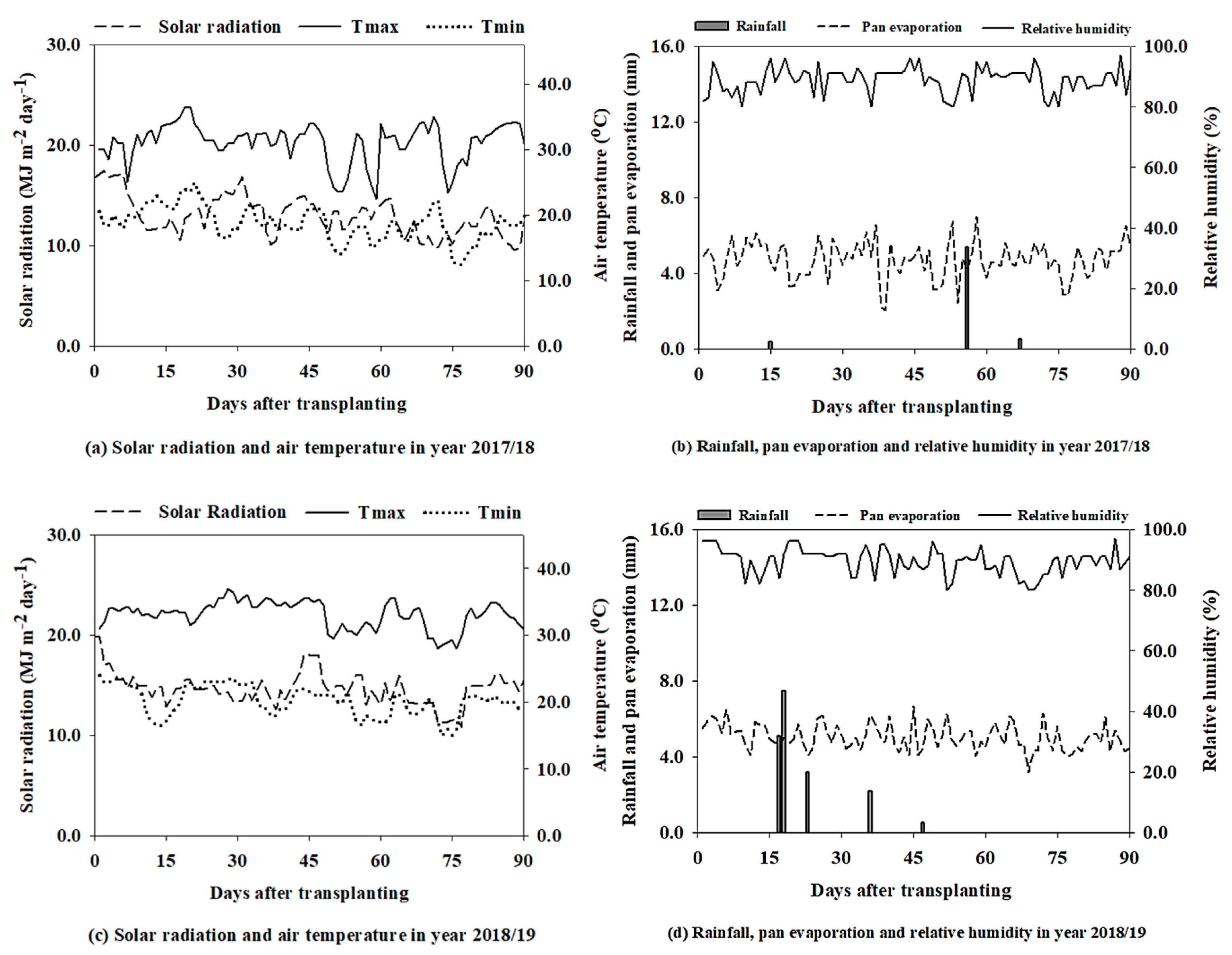
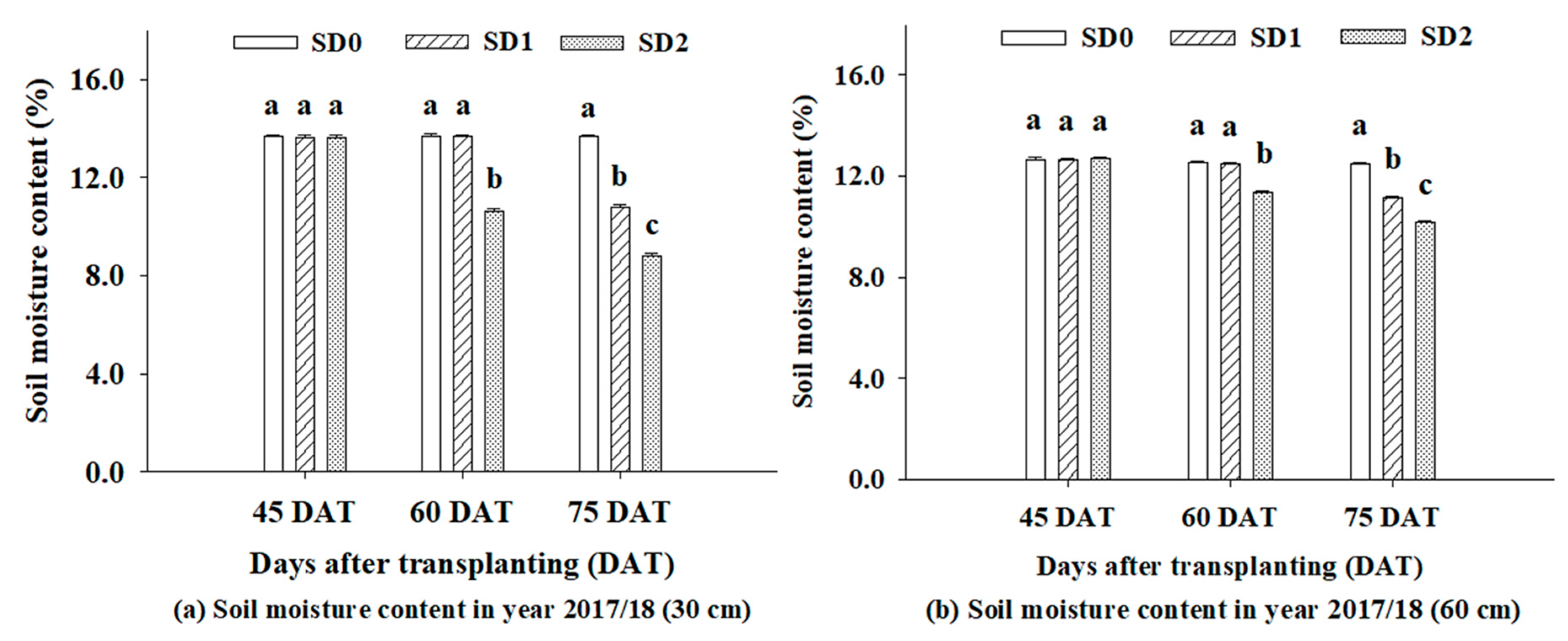
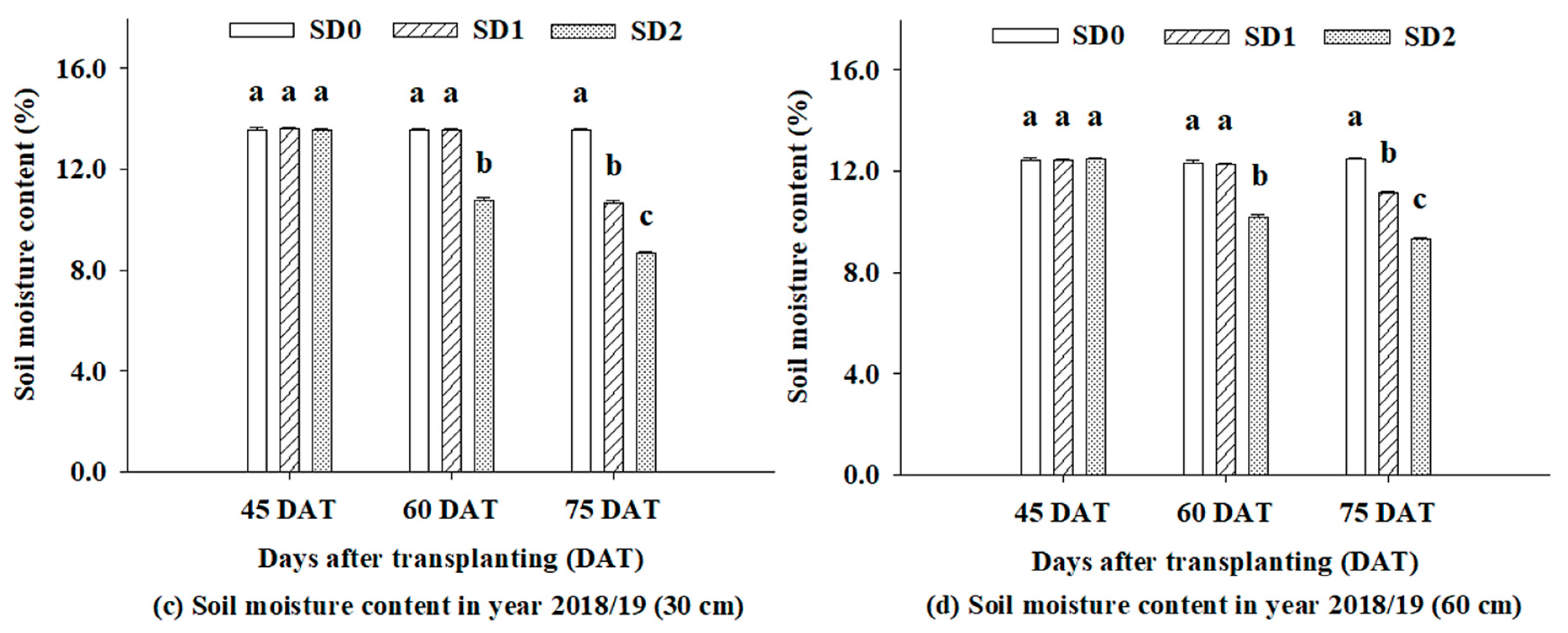
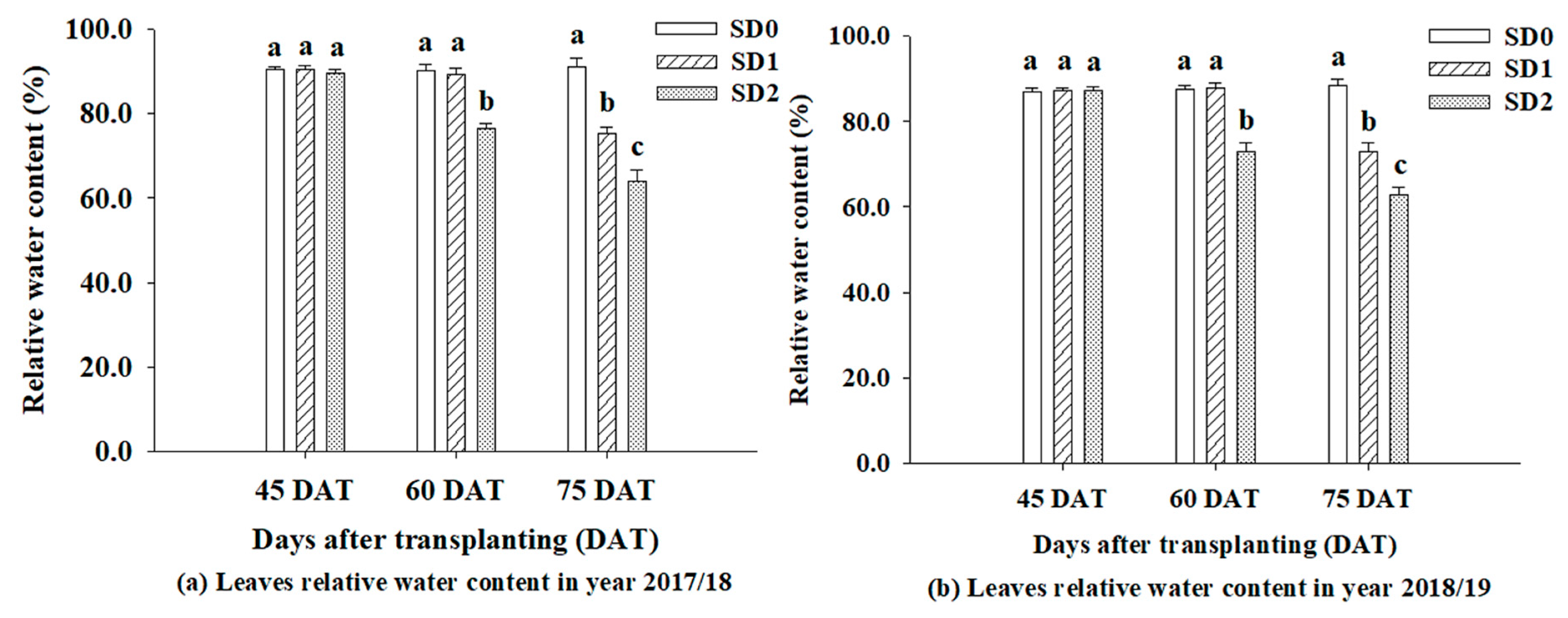
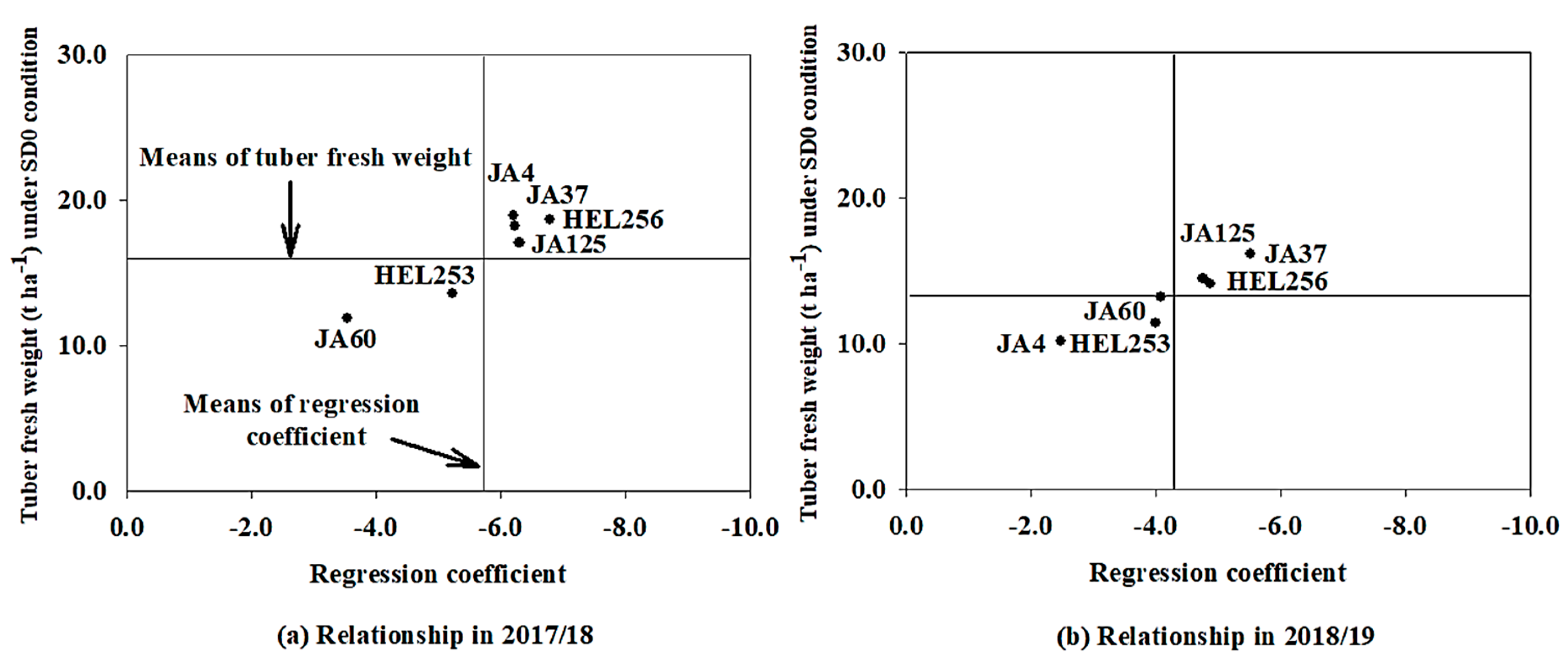
| Soil Properties | 2017/18 | 2018/19 |
|---|---|---|
| Soil physical properties | ||
| Sand (%) | 88.9 | 76.4 |
| Silt (%) | 7.0 | 18.0 |
| Clay (%) | 4.0 | 5.6 |
| Texture class | Sand | Loamy Sand |
| Soil chemical properties | ||
| pH | 6.7 | 6.7 |
| Organic matter (%) | 0.4 | 0.3 |
| Total nitrogen (%) | 0.02 | 0.02 |
| Available phosphorus (mg kg−1) | 37.7 | 35.0 |
| Exchangeable potassium (mg kg−1) | 30.1 | 48.7 |
| Exchangeable calcium (mg kg−1) | 450.0 | 754.9 |
| Electrical conductivity (EC., dS m−1) | 0.02 | 0.02 |
| Cation exchange capacity (CEC) (cmol kg−1) | 3.2 | 5.3 |
| Source of Variance | DF | Total Biomass (t ha−1) | Shoot Dry Weight (t ha−1) | Tuber Dry Weight (t ha−1) | Harvest Index | Tuber Fresh Weight (t ha−1) | Number of Tubers Per Plant (no. Plant−1) | Fresh Weight Per Tuber (g Tuber−1 FW) |
|---|---|---|---|---|---|---|---|---|
| Year (Y) | 1 | 0.15 ns (0.04) 1 | 0.10 ns (0.29) | 0.07 ns (0.03) | 0.06 * (3.19) | 60.33 ** (1.88) | 83.55 * (1.59) | 0.21 ns (0.01) |
| Rep within year | 6 | 0.35 (0.60) | 0.09 (1.60) | 0.22 (0.52) | 0.01 (2.02) | 4.75 (0.89) | 7.46 (0.85) | 6.19 (2.21) |
| Drought duration (SD) | 2 | 128.17 ** (73.08) | 3.21 ** (17.85) | 85.49 ** (66.55) | 0.24 ** (24.37) | 1254.28 ** (78.12) | 826.08 ** (31.37) | 349.94 ** (41.54) |
| Y × SD | 2 | 0.05 ns (0.03) | 0.11 ns (0.64) | 0.17 ns (0.13) | 0.01 ns (1.13) | 29.39 ** (1.83) | 4.90 ns (0.19) | 8.85 ** (1.05) |
| Pooled error (a) | 12 | 0.26 (0.90) | 0.15 (5.16) | 0.36 (1.69) | 0.01 (5.95) | 1.35 (0.50) | 6.24 (1.42) | 1.37 (0.98) |
| Genotypes (G) | 5 | 6.61 ** (9.43) | 3.60 ** (50.13) | 4.68 ** (9.11) | 0.14 ** (36.69) | 39.81 ** (6.20) | 425.09 ** (40.36) | 63.65 ** (18.89) |
| Y × G | 5 | 0.63 ns (0.90) | 0.08 ns (1.12) | 0.75 * (1.45) | 0.02 ** (5.13) | 9.01 ** (1.40) | 46.16 ** (4.38) | 19.96 ** (5.92) |
| SD × G | 10 | 1.22 ** (3.48) | 0.26 ** (7.22) | 1.24 ** (4.82) | 0.01 * (3.40) | 7.36 ** (2.29) | 22.63 ** (4.30) | 13.65 ** (8.10) |
| Y × SD × G | 10 | 1.09 ** (3.10) | 0.05 ns (1.40) | 1.63 ** (6.35) | 0.01 ns (2.59) | 8.88 ** (2.76) | 18.79 ** (3.57) | 6.64 * (3.94) |
| Pooled error (b) | 90 | 0.33 (8.44) | 0.06 (14.60) | 0.27 (9.35) | 0.00 (15.53) | 1.47 (4.12) | 7.01 (11.98) | 3.25 (17.36) |
| Total | 143 | |||||||
| CV (a) | 12.96 | 32.12 | 22.13 | 14.95 | 12.60 | 15.14 | 13.78 | |
| CV (b) | 14.45 | 19.73 | 19.03 | 8.82 | 13.16 | 16.04 | 21.22 |
| Genotypes | Total Biomass (t ha−1) | Shoot Dry Weight (t ha−1) | Tuber Dry Weight (t ha−1) | ||||||||||||
|---|---|---|---|---|---|---|---|---|---|---|---|---|---|---|---|
| SD0 | SD1 | SD2 | b-Value | R2 | SD0 | SD1 | SD2 | b-Value | R2 | SD0 | SD1 | SD2 | b-Value | R2 | |
| Year 2017/18 | |||||||||||||||
| HEL256 | 6.70 a | 4.13 a | 2.83 a | −1.94 ** | 0.88 | 2.02 b | 1.76 a | 1.16 a | −0.43 ** | 0.66 | 4.68 ab | 2.36 ab | 1.67 a,b | −1.50 ** | 0.83 |
| JA37 | 5.76 a,b | 3.64 a,b | 2.79 a | −1.49 ** | 0.87 | 1.16 c | 1.03 b | 0.88 b,c | −0.14 * | 0.44 | 4.61 a,b | 2.61 a,b | 1.90 a,b | −1.35 ** | 0.88 |
| HEL253 | 5.32 b | 4.18 a | 2.16 b | −1.58 ** | 0.87 | 2.28 a | 1.88 a | 1.16 a | −0.56 ** | 0.88 | 3.04 d | 2.30 a,b | 0.99 c | −1.02 ** | 0.84 |
| JA4 | 6.52 a | 3.22 b,c | 2.94 a | −1.79 ** | 0.76 | 1.19 c | 1.00 b | 0.94 a,b | −0.12 * | 0.35 | 5.33 a | 2.21 a,b | 1.99 a | −1.67 ** | 0.76 |
| JA60 | 4.32 c | 2.85 c | 2.20 b | −1.06 ** | 0.63 | 0.82 d | 0.84 b | 0.66 c | −0.08 ns | 0.16 | 3.50 c,d | 2.02 b | 1.54 b | −0.98 ** | 0.60 |
| JA125 | 5.43 b | 3.62 a,b | 2.22 b | −1.60 ** | 0.94 | 1.11 c | 0.97 b | 0.66 c | −0.22 ** | 0.70 | 4.32 b,c | 2.65 a | 1.56 a,b | −1.38 ** | 0.92 |
| Mean | 5.68A | 3.61B | 2.52C | −1.58 | 0.83 | 1.43A | 1.25A | 0.91B | −0.26 | 0.53 | 4.25A | 2.36B | 1.61C | −1.32 | 0.81 |
| F-test | ** | ** | * | ** | ** | ** | ** | * | ** | ||||||
| Year 2018/19 | |||||||||||||||
| HEL256 | 6.47 a,b | 4.95 a | 2.72 a | −1.88 ** | 0.90 | 2.42 a | 1.68 a | 1.26 a,b | −0.58 ** | 0.53 | 4.05 b | 3.27 a | 1.46 a,b | −1.29 ** | 0.81 |
| JA37 | 7.44 a | 3.83 b | 2.65 a | −2.39 ** | 0.79 | 1.22 b | 1.15 b | 1.04 a,b,c | −0.09 ns | 0.06 | 6.22 a | 2.68 a,b | 1.61 a,b | −2.31 ** | 0.79 |
| HEL253 | 5.14 b,c | 3.40 b | 2.53 a | −1.30 ** | 0.86 | 2.03 a | 1.51 a | 1.35 a | −0.34 ** | 0.49 | 3.10 b | 1.88 c | 1.18 b | −0.96 ** | 0.76 |
| JA4 | 5.35 b,c | 3.60 b | 2.73 a | −1.31 ** | 0.89 | 1.23 b | 1.00 b,c | 0.81 c | −0.21 * | 0.35 | 3.11 b | 2.60 b | 1.93 a | −0.59 ** | 0.59 |
| JA60 | 4.99 c | 2.09 c | 2.20 a | −1.39 ** | 0.69 | 0.97 b | 0.81 c | 0.82 c | −0.07 ns | 0.13 | 4.03 b | 1.27 c | 1.38 a,b | −1.32 ** | 0.68 |
| JA125 | 5.51 b,c | 3.95 b | 2.41 a | −1.55 ** | 0.77 | 1.36 b | 0.96 b,c | 0.86 b,c | −0.25 * | 0.37 | 4.15 b | 2.99 a,b | 1.55 a,b | −1.30 ** | 0.79 |
| Mean | 5.82A | 3.64B | 2.54C | −1.64 | 0.82 | 1.54A | 1.19B | 1.02B | −0.26 | 0.32 | 4.11A | 2.45B | 1.52C | −1.30 | 0.74 |
| F-test | ** | ** | ns | ** | ** | * | ** | ** | * | ||||||
| Genotypes | Harvest Index | Tuber Fresh Weight (t ha−1) | Number of Tubers Per Plant (no. Plant−1) | Fresh Weight Per Tuber (g Tuber−1 FW) | ||||||||||||||||
|---|---|---|---|---|---|---|---|---|---|---|---|---|---|---|---|---|---|---|---|---|
| SD0 | SD1 | SD2 | b-Value | R2 | SD0 | SD1 | SD2 | b-Value | R2 | SD0 | SD1 | SD2 | b-Value | R2 | SD0 | SD1 | SD2 | b-Value | R2 | |
| Year 2017/18 | ||||||||||||||||||||
| HEL256 | 0.70 b | 0.57 b | 0.59 b | −0.05 ns | 0.31 | 18.63 a | 8.40 a,b | 5.05 a,b | −6.79 ** | 0.89 | 21.24 b,c | 16.37 b | 12.47 b,c | −4.38 ** | 0.62 | 13.46 a | 7.76 b | 6.20 a,b | −3.63 ** | 0.77 |
| JA37 | 0.80 a | 0.72 a | 0.68 a,b | −0.06 ** | 0.86 | 18.19 a | 9.48 a | 5.75 a,b | −6.22 ** | 0.92 | 21.88 b,c | 17.90 b | 14.00 b | −3.94 ** | 0.83 | 12.46 a | 8.03 b | 6.13 a,b | −3.17 ** | 0.88 |
| HEL253 | 0.57 c | 0.55 b | 0.45 c | −0.06 ** | 0.63 | 13.60 b | 7.44 b | 3.13 c | −5.23 ** | 0.90 | 15.22 d | 12.16 c | 7.93 d | −3.64 ** | 0.62 | 14.02 a | 9.22 b | 5.83 a,b | −4.09 ** | 0.73 |
| JA4 | 0.82 a | 0.68 a | 0.68 a,b | −0.07 ** | 0.67 | 18.91 a | 7.98 a,b | 6.50 a | −6.21 ** | 0.81 | 30.44 a | 25.23 a | 21.03 a | −4.70 ** | 0.66 | 9.35 b | 4.78 c | 4.74 b | −2.30 ** | 0.66 |
| JA60 | 0.80 a | 0.71 a | 0.69 a | −0.06 ns | 0.29 | 11.83 b | 7.06 b | 4.74 b | −3.54 ** | 0.86 | 23.75 b | 18.45 b | 12.44 b,c | −5.66 ** | 0.75 | 7.71 b | 5.77 c | 5.71 a,b | −1.00 ns | 0.28 |
| JA125 | 0.80 a | 0.73 a | 0.70 a | −0.05 ** | 0.46 | 17.07 a | 9.31 a | 4.46 b,c | −6.30 ** | 0.96 | 18.20 c,d | 12.25 c | 9.79 c,d | −4.21 ** | 0.83 | 14.06 a | 11.47 a | 6.91 a | −3.58 ** | 0.84 |
| Mean | 0.75A | 0.66B | 0.63B | −0.06 | 0.54 | 16.37A | 8.28B | 4.94C | −5.72 | 0.89 | 21.79A | 17.06B | 12.94C | −4.42 | 0.72 | 11.84A | 7.84B | 5.92C | −2.96 | 0.69 |
| F-test | ** | ** | ** | ** | * | ** | ** | ** | ** | ** | ** | * | ||||||||
| Year 2018/19 | ||||||||||||||||||||
| HEL256 | 0.63 c | 0.66 b,c | 0.54 a,b | −0.05 ns | 0.21 | 14.14 b | 10.00 a | 4.38 a | −4.88 ** | 0.93 | 24.73 a | 17.60 b | 9.58 c | −7.57** | 0.90 | 8.70 c | 8.58 a,b | 6.90 a | −0.90 ns | 0.26 |
| JA37 | 0.83 a | 0.70 a,b | 0.62 a | −0.10 ** | 0.56 | 16.19 a | 9.52 a | 5.14 a | −5.52 ** | 0.86 | 16.96 b | 16.98 b | 14.24 a,b | −1.36 ns | 0.22 | 14.61 a | 8.45 b | 5.46 a | −4.57 ** | 0.75 |
| HEL253 | 0.61 c | 0.54 d | 0.46 b | −0.07 ns | 0.29 | 11.43 c,d | 6.00 b,c | 3.43 a | −4.00 ** | 0.92 | 14.95 b | 11.23 c | 11.69 b,c | −1.63 ns | 0.17 | 11.61 b,c | 8.59 a,b | 4.77 a | −3.42 ** | 0.70 |
| JA4 | 0.72 b | 0.54 d | 0.47 b | −0.13 ** | 0.92 | 10.19 d | 6.95 b | 5.24 a | −2.48 ** | 0.81 | 27.71 a | 25.26 a | 15.41 a | −6.14 ** | 0.78 | 5.55 d | 4.17 c | 5.13 a | −0.21 ns | 0.03 |
| JA60 | 0.80 a | 0.61 c,d | 0.62 a | −0.09 * | 0.43 | 13.24 b,c | 5.04 c | 5.05 a | −4.09 ** | 0.69 | 16.44 b | 8.80 c | 10.43 c | −3.00 * | 0.39 | 12.22 a,b | 9.52 a,b | 7.41 a | −2.40 * | 0.40 |
| JA125 | 0.75 a,b | 0.75 a | 0.64 a | −0.06 ns | 0.31 | 14.48 a,b | 8.86 a | 4.95 a | −4.76 ** | 0.90 | 18.35 b | 11.38 c | 11.58 b,c | −3.38 * | 0.44 | 12.34 a,b | 11.83 a | 6.43 a | −2.95 ** | 0.53 |
| Mean | 0.72A | 0.63B | 0.56C | −0.08 | 0.45 | 13.28A | 7.73B | 4.70C | −4.29 | 0.85 | 19.86A | 15.21B | 12.15C | −3.85 | 0.48 | 10.84A | 8.52B | 6.02C | −2.41 | 0.44 |
| F-test | ** | ** | * | ** | ** | ns | ** | ** | ** | ** | ** | ns | ||||||||
© 2020 by the authors. Licensee MDPI, Basel, Switzerland. This article is an open access article distributed under the terms and conditions of the Creative Commons Attribution (CC BY) license (http://creativecommons.org/licenses/by/4.0/).
Share and Cite
Chaimala, A.; Jogloy, S.; Vorasoot, N.; Toomsan, B.; Jongrungklang, N.; Kesmala, T.; Holbrook, C.C.; Kvien, C.K. Responses of Total Biomass, Shoot Dry Weight, Yield and Yield Components of Jerusalem Artichoke (Helianthus tuberosus L.) Varieties under Different Terminal Drought Duration. Agriculture 2020, 10, 198. https://doi.org/10.3390/agriculture10060198
Chaimala A, Jogloy S, Vorasoot N, Toomsan B, Jongrungklang N, Kesmala T, Holbrook CC, Kvien CK. Responses of Total Biomass, Shoot Dry Weight, Yield and Yield Components of Jerusalem Artichoke (Helianthus tuberosus L.) Varieties under Different Terminal Drought Duration. Agriculture. 2020; 10(6):198. https://doi.org/10.3390/agriculture10060198
Chicago/Turabian StyleChaimala, Aunchana, Sanun Jogloy, Nimitr Vorasoot, Banyong Toomsan, Nuntawoot Jongrungklang, Thawan Kesmala, C. Corley Holbrook, and Craig K. Kvien. 2020. "Responses of Total Biomass, Shoot Dry Weight, Yield and Yield Components of Jerusalem Artichoke (Helianthus tuberosus L.) Varieties under Different Terminal Drought Duration" Agriculture 10, no. 6: 198. https://doi.org/10.3390/agriculture10060198
APA StyleChaimala, A., Jogloy, S., Vorasoot, N., Toomsan, B., Jongrungklang, N., Kesmala, T., Holbrook, C. C., & Kvien, C. K. (2020). Responses of Total Biomass, Shoot Dry Weight, Yield and Yield Components of Jerusalem Artichoke (Helianthus tuberosus L.) Varieties under Different Terminal Drought Duration. Agriculture, 10(6), 198. https://doi.org/10.3390/agriculture10060198





